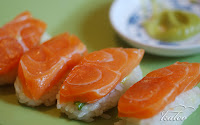At the restaurant (Trax Cafe), making the stuff is routine, and must be done in order to compliment the wonderful meat dishes prepared such as Filet Mignon, Rack of Lamb and other specialty meat dishes. The process of making the brown sauce and espagnole is an all day and into the next day job. Unless of course, you happen to have extra brown sauce hanging around or that you prepared earlier and froze.
For me, getting the veal bones for the brown stock is challenge enough and once I make it, there is more than an abundant quantity for my personal use so this is truly a rare occurrence for me or any other home chef. Check with your local butcher for the availability of veal bones.
I begin by making the "brown stock", as this is also used to
 make the espagnole (French for Spanish, although the sauce has little connection with Spanish cuisine). The brown begins with the roasting of the bones, veal bones have a higher degree of collagen than beef bones and adds more body in the form of gelatin to enrich the stock.
make the espagnole (French for Spanish, although the sauce has little connection with Spanish cuisine). The brown begins with the roasting of the bones, veal bones have a higher degree of collagen than beef bones and adds more body in the form of gelatin to enrich the stock.The bones are
 roasted alone first to begin the break down process of the enzymes in the marrow for about an hour. The roasted bones are then coated with tomato paste and other vegetables (mirepoix) are added, carrots,
roasted alone first to begin the break down process of the enzymes in the marrow for about an hour. The roasted bones are then coated with tomato paste and other vegetables (mirepoix) are added, carrots,  onions and celery (some chefs omit celery as they claim the flavoring is too aggressive). The bones and mirepoix is then roasted for about another half an hour to help the tomato paste begins to aide the breakdown of cartilage and other connective tissue.
onions and celery (some chefs omit celery as they claim the flavoring is too aggressive). The bones and mirepoix is then roasted for about another half an hour to help the tomato paste begins to aide the breakdown of cartilage and other connective tissue. Af
 ter further roasting the bones and mirepoix, transfer the bones from the roasting pan into a large stock pot. With the rest of the mirepoix in the roasting pan, add a little wine and water to deglaze the the pan, scraping up the brown bits (fond) on the bottom of the pan.
ter further roasting the bones and mirepoix, transfer the bones from the roasting pan into a large stock pot. With the rest of the mirepoix in the roasting pan, add a little wine and water to deglaze the the pan, scraping up the brown bits (fond) on the bottom of the pan. Add COLD water to cover the bones in the stock pot.
 Cold water dissolves certain proteins (albumin) which helps clarify and keep the stock clearer. Now add the deglazed mirepoix and contents back to the stock pot with the bones. Add enough water to cover the entire contents about 8 quarts. To the stock add a Bouquet Garni, a bundle of herbs tied together with string, to add flavor and the string helps facilitate removing later. The Bouquet is usually made up of fresh bay leaves, rosemary, thyme and parsley. I bundled it up in a jacket of leeks.
Cold water dissolves certain proteins (albumin) which helps clarify and keep the stock clearer. Now add the deglazed mirepoix and contents back to the stock pot with the bones. Add enough water to cover the entire contents about 8 quarts. To the stock add a Bouquet Garni, a bundle of herbs tied together with string, to add flavor and the string helps facilitate removing later. The Bouquet is usually made up of fresh bay leaves, rosemary, thyme and parsley. I bundled it up in a jacket of leeks.Bring the mi
 xture to a boil and lower temperature to a simmer. Now comes the reduction process, with the stock at low heat, simmer for 6 hours or more, I simmered the stock for 10 hours, frequently skimming the top of frothy scum as it rises. The longer you simmer the more intense the flavor and body. After a while the liquid will assume a nice deep dark color. The reduction process obviously removes liquid so be sure to keep the liquid level to 4 quarts.
xture to a boil and lower temperature to a simmer. Now comes the reduction process, with the stock at low heat, simmer for 6 hours or more, I simmered the stock for 10 hours, frequently skimming the top of frothy scum as it rises. The longer you simmer the more intense the flavor and body. After a while the liquid will assume a nice deep dark color. The reduction process obviously removes liquid so be sure to keep the liquid level to 4 quarts.After the simmer reduction, remove the bones
 (you can retain these for another round of simmering or a remouillage ). Strain the stock through a sieve or cheese cloth. Place the stock in a sink with cold water to reduce the heat to 70º after simmering to avoid the growth of bacteria. Now you're about ready to move onto the Espagnole, the other half of the Demi Glace.
(you can retain these for another round of simmering or a remouillage ). Strain the stock through a sieve or cheese cloth. Place the stock in a sink with cold water to reduce the heat to 70º after simmering to avoid the growth of bacteria. Now you're about ready to move onto the Espagnole, the other half of the Demi Glace.____________________________________________



















































